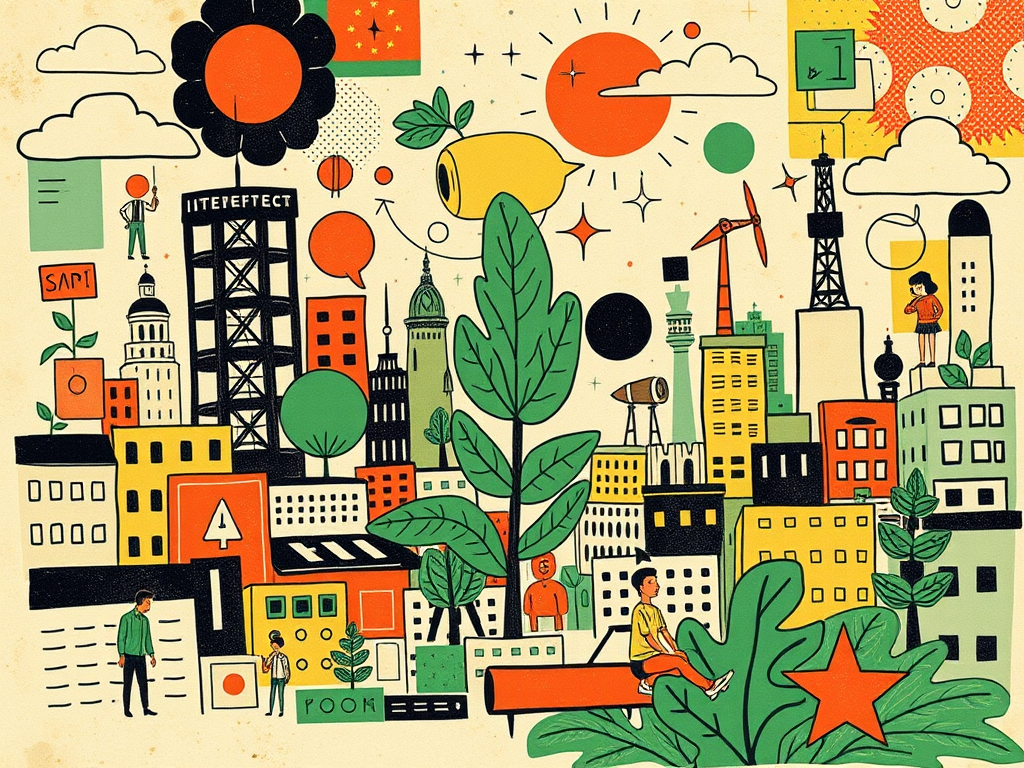
Green Investments: Climate Goals Creating New Market Opportunities
Reading time: 15 minutes
Table of Contents
- Introduction to Green Investments
- The Global Shift Towards Sustainability
- Key Sectors Driving Green Investment Opportunities
- Economic Impact of Climate Goals
- Challenges and Risks in Green Investing
- Future Outlook for Green Investments
- Conclusion
- FAQs
1. Introduction to Green Investments
As the world grapples with the urgent need to address climate change, green investments have emerged as a powerful tool for driving sustainable economic growth while simultaneously tackling environmental challenges. This comprehensive analysis delves into the intricate relationship between climate goals and the burgeoning market opportunities they create, offering insights into the economic dynamics shaping our transition to a more sustainable future.
Green investments, broadly defined as financial activities that support environmentally friendly projects and initiatives, have gained significant traction in recent years. This surge in interest is not merely a reflection of growing environmental consciousness but also a recognition of the substantial economic potential inherent in sustainable technologies and practices.
2. The Global Shift Towards Sustainability
The global shift towards sustainability is underpinned by a complex interplay of factors, including policy initiatives, technological advancements, and changing consumer preferences. This section examines the key drivers propelling the green investment revolution.
2.1 International Climate Agreements
The Paris Agreement of 2015 marked a watershed moment in global climate action, setting ambitious targets for reducing greenhouse gas emissions and limiting global temperature rise. This landmark accord has catalyzed a wave of policy reforms and investment reallocations across the globe, creating a fertile ground for green investments.
2.2 Corporate Sustainability Commitments
An increasing number of corporations are making bold sustainability commitments, driven by a combination of stakeholder pressure, regulatory expectations, and recognition of long-term business benefits. These corporate initiatives are creating substantial demand for green technologies and services, further fueling investment opportunities.
2.3 Evolving Consumer Preferences
Consumer preferences are rapidly evolving, with a growing segment of the population prioritizing eco-friendly products and services. This shift is compelling businesses across sectors to adapt their offerings and operations, opening up new avenues for green investments.
3. Key Sectors Driving Green Investment Opportunities
The transition to a low-carbon economy is creating investment opportunities across a wide range of sectors. This section explores some of the most promising areas for green investments.
3.1 Renewable Energy
The renewable energy sector continues to be at the forefront of green investments. Solar and wind power, in particular, have seen dramatic cost reductions and efficiency improvements, making them increasingly competitive with traditional fossil fuel-based energy sources. As countries strive to meet their climate goals, investments in renewable energy infrastructure are expected to surge.
3.2 Energy Efficiency
Energy efficiency technologies and services represent another significant area of opportunity. From smart building systems to industrial process optimizations, investments in energy efficiency not only contribute to emissions reduction but also offer attractive returns through cost savings.
3.3 Sustainable Transportation
The transportation sector is undergoing a profound transformation, with electric vehicles (EVs) and alternative fuel technologies gaining rapid market share. Investments in EV manufacturing, charging infrastructure, and battery technologies are poised for substantial growth as countries move to phase out internal combustion engines.
3.4 Green Real Estate
The real estate sector is increasingly embracing sustainability, with green building practices becoming mainstream. Investments in energy-efficient buildings, sustainable urban development projects, and green retrofits are gaining traction. For those interested in international real estate opportunities with a sustainability focus, property for sale greece offers a unique blend of Mediterranean charm and growing commitment to eco-friendly development.
4. Economic Impact of Climate Goals
The pursuit of climate goals is having a profound impact on the global economy, reshaping industries and creating new economic paradigms. This section examines the multifaceted economic implications of the transition to a low-carbon future.
4.1 Job Creation and Economic Growth
Contrary to concerns about economic trade-offs, the transition to a green economy is proving to be a significant driver of job creation and economic growth. The International Renewable Energy Agency (IRENA) estimates that the renewable energy sector alone could employ 42 million people by 2050, up from 11 million in 2018. This job growth extends beyond direct employment in green industries to encompass a wide range of ancillary services and supply chain roles.
4.2 Innovation and Technological Advancement
The push for sustainability is accelerating innovation across multiple sectors. From breakthroughs in battery technology to advancements in carbon capture and storage, climate goals are spurring rapid technological progress. This innovation drive is not only creating new market opportunities but also enhancing overall economic productivity and competitiveness.
4.3 Financial Market Transformation
Climate goals are catalyzing a transformation in financial markets, with sustainability considerations increasingly integrated into investment decisions. The rise of green bonds, sustainability-linked loans, and ESG (Environmental, Social, and Governance) investing is reshaping capital allocation patterns and creating new financial instruments tailored to support the transition to a low-carbon economy.
5. Challenges and Risks in Green Investing
While the opportunities in green investments are substantial, they are not without challenges and risks. This section explores some of the key considerations for investors navigating this evolving landscape.
5.1 Policy and Regulatory Uncertainty
The green investment landscape is heavily influenced by government policies and regulations, which can be subject to change. Policy shifts or inconsistencies across jurisdictions can create uncertainty for investors and impact the viability of green projects. Careful analysis of policy trends and scenario planning are essential for mitigating these risks.
5.2 Technological Risks
Many green technologies are still evolving, and there is always the risk of technological obsolescence or underperformance. Investors need to carefully assess the maturity and reliability of technologies, as well as the potential for disruptive innovations that could alter market dynamics.
5.3 Market and Competitive Risks
As the green investment space becomes increasingly crowded, there is a risk of market saturation in certain sectors. Additionally, competition from incumbent industries and the potential for price volatility in commodities like rare earth metals used in green technologies pose challenges for investors.
6. Future Outlook for Green Investments
The future of green investments looks promising, with several trends pointing towards continued growth and evolution of the sector.
6.1 Increased Mainstreaming of Green Investments
Green investments are increasingly moving from niche to mainstream, with major financial institutions and institutional investors allocating significant capital to sustainable projects. This trend is expected to accelerate, driven by growing recognition of the financial materiality of climate risks and opportunities.
6.2 Expansion into New Sectors
While sectors like renewable energy and electric vehicles have been at the forefront of green investments, we are likely to see increased focus on areas such as sustainable agriculture, circular economy solutions, and nature-based climate solutions. These emerging sectors offer new frontiers for innovation and investment.
6.3 Integration of Digital Technologies
The intersection of green technologies with digital innovations like artificial intelligence, blockchain, and the Internet of Things is opening up new possibilities for enhancing sustainability and creating investment opportunities. Smart grid technologies, precision agriculture, and AI-driven energy management systems are just a few examples of this convergence.
7. Conclusion
The pursuit of climate goals is reshaping the global economic landscape, creating a wealth of opportunities for green investments. From renewable energy and sustainable transportation to green real estate and innovative financial instruments, the transition to a low-carbon economy is opening up new markets and driving technological innovation.
While challenges and risks remain, the momentum behind green investments appears unstoppable. As policy frameworks mature, technologies advance, and consumer preferences continue to evolve, the economic case for sustainable investments is becoming increasingly compelling.
For investors, policymakers, and businesses alike, understanding and leveraging these trends will be crucial for navigating the economic transitions ahead. The green investment revolution is not just about mitigating climate risks; it’s about capitalizing on one of the most significant economic opportunities of our time.
As we move forward, the synergy between climate goals and market opportunities will likely intensify, further accelerating the transition to a sustainable, low-carbon future. Those who recognize and act on these opportunities early stand to benefit not only financially but also in contributing to a more sustainable world for future generations.
8. FAQs
Q1: What are green investments?
A1: Green investments refer to financial activities that support environmentally friendly projects and initiatives. These can include investments in renewable energy, energy efficiency technologies, sustainable transportation, green real estate, and other sectors that contribute to mitigating climate change and promoting environmental sustainability.
Q2: How do climate goals create market opportunities?
A2: Climate goals, such as those set in international agreements like the Paris Accord, drive policy changes, technological innovation, and shifts in consumer preferences. These factors create demand for new products, services, and technologies that support sustainability, opening up market opportunities across various sectors.
Q3: What are some of the risks associated with green investments?
A3: Some key risks include policy and regulatory uncertainty, technological risks (such as the potential for technological obsolescence), market and competitive risks, and the challenges of scaling up new technologies. Additionally, as with any investment, there’s always the risk of market volatility and economic downturns affecting returns.
Q4: How is the financial sector adapting to the rise of green investments?
A4: The financial sector is adapting by developing new financial products like green bonds and sustainability-linked loans, integrating ESG (Environmental, Social, and Governance) criteria into investment decisions, and creating specialized funds focused on sustainable investments. Many major financial institutions are also committing to aligning their portfolios with climate goals.
Q5: What role does technology play in green investments?
A5: Technology plays a crucial role in green investments, both as a target for investment (e.g., renewable energy technologies, energy storage solutions) and as an enabler for sustainability across sectors. Emerging technologies like AI, blockchain, and IoT are being integrated with green solutions to enhance efficiency, traceability, and overall environmental impact.

Article reviewed by Devon Bergnaum, Residential Property Consultant | Helping Clients Find Dream Homes, on March 23, 2025




